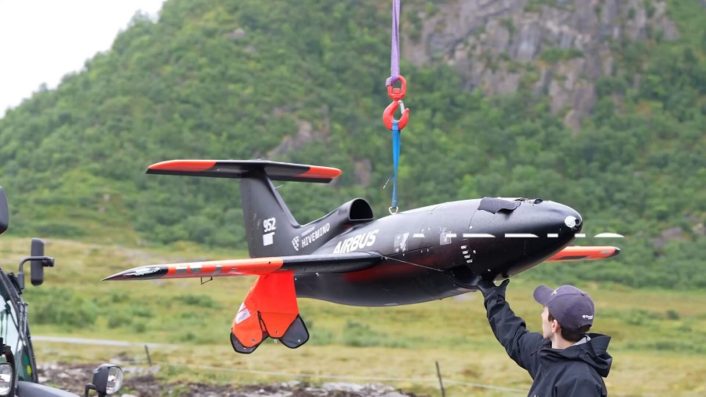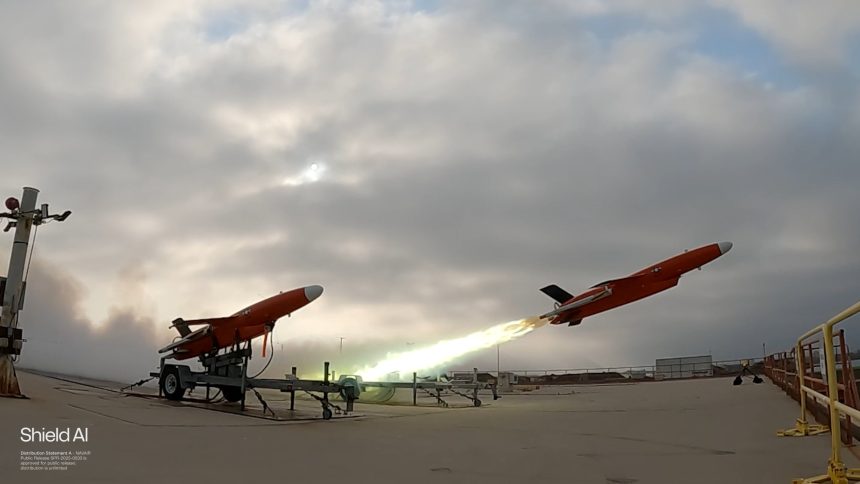Shield AI’s Hivemind powered autonomous BQM-177A threat-representative maneuvers for the U.S. Navy and DT25 counter-UAV tracking trials in Norway.
NAVAIR (Naval Air Systems Command) and Shield AI announced on Sep. 22, 2025, the test flight of two Kratos BQM-177A aerial targets with the latter’s proprietary Hivemind flight autonomy software. The goal was to recreate “more threat-representative flight profiles and […] maneuvering seen in adversary tactics.”
Shield subsequently revealed the test, which NAVAIR said was conducted on Aug. 5, explored operational and technological concepts for the CCA (Collaborative Combat Aircraft) program. The trial supported the U.S. Navy’s “first beyond-visual-range (BVR) autonomy mission on a fast-moving platform,” conducted under the Experimental Platform for Intelligent Combat (EPIC) project.
The test at the Point Mugu Sea Range in California follows an August 2024 contract from NAVAIR to Shield “to integrate its Hivemind AI pilot software and deliver a robust prototype test bed using the BQM-177A to demonstrate autonomous operations during flight.” The demonstration, that validated “manned-unmanned teaming goals,” was overseen by the Navy’s Strike Planning and Execution (PMA-281) and Aerial Targets (PMA-208) programs. Another test is planned later this year.
Informing future @USNavy CCA concepts: BQM-177A, powered by Hivemind.
Mission autonomy has never been so EPIC. In collaboration with @NAVAIRNews‘ Strike Planning and Execution Program (PMA-281) and Aerial Targets Program (PMA-208), Hivemind successfully flew the BQM-177A,… pic.twitter.com/G4dSUEtC8L
— Shield AI (@shieldaitech) September 22, 2025
Hivemind AI
NAVAIR described Hivemind as enabling the aircraft to “operate independently using real-time sensor data and onboard processing to make decisions, plan routes and execute maneuvers without remote input.” Furthermore, the statement says “the software is designed as an open, modular platform that can be used across a range of DoD systems.”
Kratos, the BQM-177A’s developer, integrated the Hivemind on the system as part of a broader development effort.
Interestingly, Shield AI also announced on Sep. 23 the test of the Airbus Defence and Space’s DT25 target drone with the Hivemind software at Andøya, Norway. “The aircraft autonomously tracked a live-flying adversary aircraft (red agent) in both permissive and degraded environments,” said Shield AI.
Shield AI’s Hivemind is also powering GA-ASI’s MQ-20 Avenger UCAV, which has demonstrated simulated and live Beyond Line-of-Sight (BLOS) air-to-air engagements in progressively complex and real-world scenarios. Hivemind also governed Airbus’s MQ-72C Lakota unmanned rotary-wing platform’s first autonomous test flight at Grand Prairie in Texas.
View this post on Instagram
Trials with Hivemind-enabled BQM-177A
NAVAIR said that, of the two BQM-177As integrated with the Hivemind AI, one demonstrated Advanced Vehicle Control Laws (AVCL), while the other performed “additional autonomous behaviours.” AVCL “enables aircraft to fly complex, dynamic maneuvers by translating high-level mission commands into real-time flight control inputs,” added the Command.
Shield AI clarified that AVCL, a Kratos technology, had been “updated” following “flight clearance through the Navy’s rigorous safety and airworthiness process.” AVCL enables the BQM-177A to fly “more threat-representative flight profiles and the kind of maneuvering seen in adversary tactics,” according to NAVAIR.
PMA-208 program manager Greg Wise added the ability to “simulate realistic interactions with fleet assets, provides more effective test and training scenarios.” NAVAIR further touched upon how the BQM-177A “replicates modern subsonic anti-ship cruise missile threats and supports a range of missions with its internal and external payload options” for “both developmental and operational testing for fleet training.”

The BQM-177A performing “more advanced maneuvers and closer engagements, allowing the target to more accurately simulate interactions with manned ships,” represents a need to be able to tackle the growing threat of one-way attack munitions and asymmetric threats seen in the U.S. Navy’s war in the Red Sea.
Iran and Houthi threats are not only likely to persist, but even advance further after intense exchanges with Israel, with Tehran sure to be improving its guidance, propulsion and seeker technology, and passing that to the Yemeni group. Future OWA munitions could be more advanced in their maneuvering and kinematic capabilities, shedding light on the significance of the Hivemind’s integration on the BQM-177A.
Use in CCAs
Saying that this was the “first time Hivemind autonomously flew the BQM-177A,” Shield AI explained the test “demonstrated successful control handoff, onboard system communication, and integration with Kratos’ updated Advanced Vehicle Control Laws (AVCL),” touching upon the testing parameters. Shield AI then revealed how the Hivemind-BQM177A test also supports the broader CCA effort:
“Originally designed as a high-performance aerial target, the BQM-177A served in this test as a low-cost autonomy research platform, generating insights that may inform Navy Collaborative Combat Aircraft (CCA) concepts. Its use in this role gives the Navy a strategic asset to de-risk autonomy development when operational assets are unavailable or cost-prohibitive, accelerating Naval Aviation’s path to fleet integration.”
Airbus DT25 powered by Hivemind: Autonomous tracking in degraded environments
In collaboration with @AirbusDefence, Shield AI successfully integrated Hivemind onto Airbus’ DT25 target drone in just three months. The DT25 autonomously identified, tracked, and engaged a live… pic.twitter.com/R49eJocUxz
— Shield AI (@shieldaitech) September 23, 2025
Hivemind’s trials with GA-ASI’s MQ-20 Avenger are also feeding the CCA program, where General Atomics is also the developer of one of the Air Force’s two UCAVs, the YFQ-42A. This reinforces “Hivemind’s growing role across a broad set of sophisticated aircraft,” said Shield AI.
Shield AI’s press release quoted PMA-281 program manager Capt. Todd Smith, who said, “Future air combat will require machine decision-making at machine speed.” The company further added “We’re investing in autonomy now, so we can deliver smarter, more adaptable capabilities to the fleet before they’re urgently needed.”
Hivemind and DT25 Target Drone test
Hivemind was integrated with the DT25 within three months and the successful flight demonstration test in Norway saw the aircraft “autonomously tracking a live-flying adversary aircraft (red agent) in both permissive and degraded environments.”
“The demonstration represented a counter-UAS mission profile, showcasing Hivemind’s ability to identify, track, and respond to airborne threats autonomously.” Although unrelated, this test also comes after the Russian drone incursion into Poland, which has triggered an increased NATO air deployment in the form Eastern Sentry.
However, while this test was in the works much before the Russian drone incident, it may have been inspired by Europe’s participation in Operation Prosperity Guardian against the Houthis, which saw British and French warships tackle munitions launched by the group. It remains to be seen whether this test suggests Airbus might develop low-cost, AI-enabled drone-based counter-UAV systems.
“The future of defense includes to a large extent advancements of autonomous capabilities for manned and unmanned assets,” said Thomas Grohs, Head of Unmanned Aerial Systems Programs at Airbus Defence and Space.









